Chapter 2 Lecture 2 语言学
- 格式:ppt
- 大小:501.50 KB
- 文档页数:3

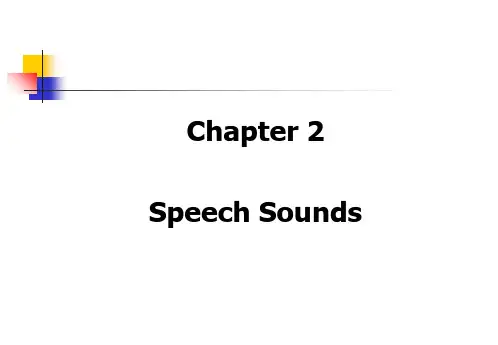
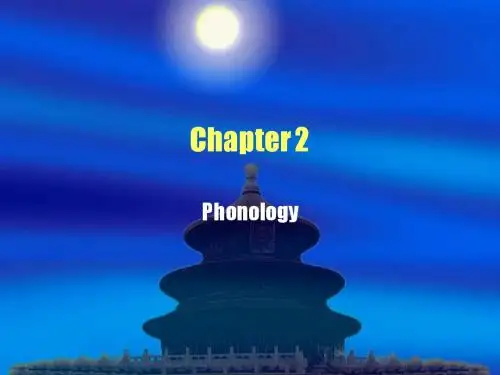
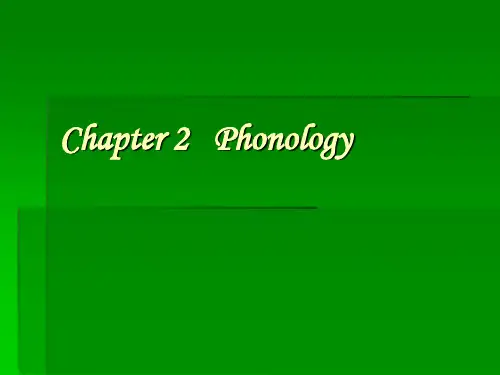
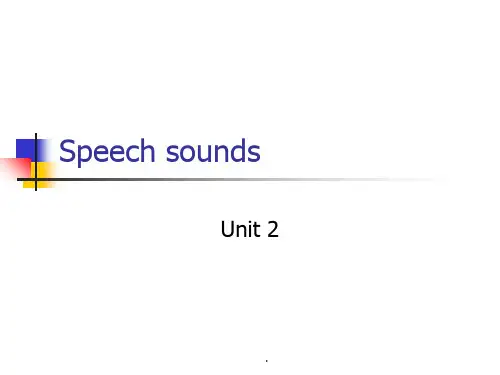

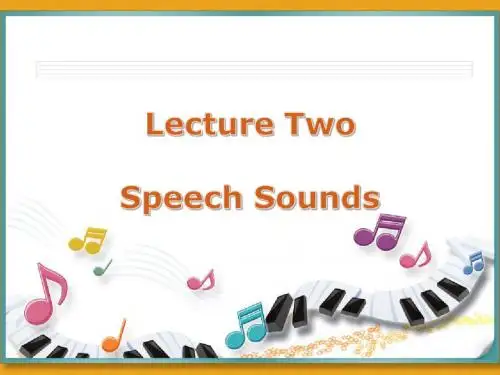
A New Seaghsounds of spoken English≠letters of written English↓InternationalPhonetic Alphabet →IPAIPA is a standardized and internally accepted system of phonetic transcription.Its basic principle is using a different letter for each distinguishable speech sounds. With minor modification it is now still used by phoneticians and linguists.The International Phonetic Alphabet (Revised to 2005)only some of the sounds →units in the language system.study from various perspectives ↓PhoneticsPhonologyPhonetics -studies how speech sounds are produced, transmitted, and perceived.Articulatory Phonetics- the study of the production of speech sounds.Acoustic Phonetics- the study of the physical properties of speech sounds. Perceptual or Auditory Phonetics - concerned with the perception of speech sounds.- the study of the sound patterns and sound systems of languages. Aim- discover the principles that govern the way sounds are organized in languages, and to explain the variations that occur.1- analyze an individual language, say English, in order to determine itsphonological structure, i.e. whichsound units are used and how they are put together.2- compare the properties of sound systems in different languages in order to make hypotheses about the rulesthat underlie the use of sounds inthem, and3- ultimately discover the rules that underlie the sound patterns of alllanguages.nasal cavityoral cavitypharyngealcavityThe three resonating cavitiesSpeech Organs 1.lips 2.teeth 3.teeth ridge (alveolar) 4.hard palate 5.soft palate (velum) 6.uvula 7.tip of the tongue 8.blade of the tongue 9.front of the tongue 10.back of the tongue11.vocal cords1 2 1 234 567 8 910 11MouthConsonants are produced ‘by a closure in the vocal tract, or by a narrowing which is so marked that air cannot escape without producing audible friction’.By contrast, a vowel is produced without such ‘stricture’ so that ‘air escapes in a relatively unimpeded way through the mouth or nose’.The distinction between vowels and consonants lies in the obstruction of airstream.As there is no obstruction of air in the production of vowels, the description of the consonants and vowels cannot be done along the same lines.The place of articulation refers to the point where a consonant is made.Consonants - any place between the lips and the vocal folds.Bilabial双唇音*[w] tongue body raises to velum →labia-velar[f], [v]Upper teeth & Lower lip 唇齿音[ð], [θ]Tongue tip/blade & teeth 齿音[t], [d], [s], [z], [n], [l] , [ ]tongue tip/blade&alveolar ridge齿龈音[ſ],[3],([tſ],[d3])tongue tip&back of the alveolar ridge 后齿龈音[j][k], [g], [η], [w] [h] Palatal 硬腭音Velars 软腭音Glottal 声门音[ ] - 书[ u] [ ][ ] [ ] Retroflex 卷舌音Uvular 小舌音Pharyngeal喉音Place of Articulation Bilabial [p], [b], [m], [w] Labiodental [f], [v]Dental [ð], [θ]Alveolar [t], [d], [s], [z], [n], [l], Post-alveolar [ſ], [3],Palatal [j]Velar [k], [g], [η], [w] Glottal [h]RetroflexUvularPharyngealComplete closure(articulators)→ airstreamcannot escapethrough themouth.1.Closing phasepression3.release [p], [b], [k], [g], [t], [d]爆破音(plosive)Most sounds are produced orally, with the velum raised, preventing air flow from entering the nasal cavity. However, when the velum is lowered and the airstream is allowed to flow out through the nose to produce sounds -nasals. [m][n][η]鼻音air stream partially obstructed and turbulent airflow is produced [f], [v] [ð], [θ] [s], [z] [ſ], [3] [h]摩擦音one articulator is close to another, but without the vocal tract being narrowed for turbulent air stream[w][j]无摩擦延续音(半元音)obstruction in the incomplete closure between one or both sides of the tongue and the roof of the mouth [l]边音塞擦音a stop followedimmediately by africativean articulator is set vibrating by the airstream [r] ( )颤音only one vibration is produced [ ]触音/闪音[p] [b] [f] [v] [m] Voiceless bilabial stopVoiced bilabial stopVoiceless labiodental fricative Voiced labiodental fricative Bilabial nasal。
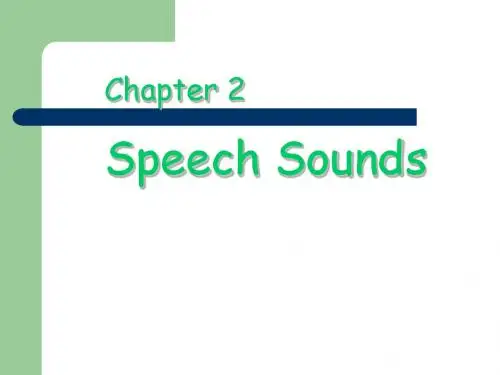

语言学chapter2Chapter 2 phonology1,what are the two major media of communication? Of the two, which one is primary and why?The two major media of communication are speech and writing. Speech is more basic than writing. Because the writing system of any language is always “invented” by its users to record speech when the need arises, and in everyday communication, speech plays a greater role than writing in terms of the amount of information conveyed, speech is always the way in which every native speaker acquires his mother tongue, and writing is learned and taught later when he goes to school.2.What is voicing and how is it caused?Vibration of the vocal cords results in a quality of speech sounds that is called voicing. It is caused by vocal cords which may also be held together tightly so that the air stream vibrates hem at different speeds .3.Explain with examples how broad transcription and narrow transcription differ.Broad transcription is the transcription with letter-symbols only. Narrow transcription is the transcription with letter-symbols together with the diacritics,which are added to the letter-symbols to bring out the finer distinctions than the letters alone can possible do. For example, in broad transcription, the symbol[l]is used for the sound[l]in the four words leaf[li:f],feel[fi:l], build[bild],and health[helθ]. As a matter of fact, the sound [l]in all these four sound combination differ slightly. The [l]in[li:f], occurring before a vowel, is called clear[l], and no diacritic is need to indicate it; the [l]in[fi:l]and[bild]occurring at the end of a word or before another consonant, is pronounced differently from the clear [1] as in “leaf”. It is called dark [?] and innarr ow transcription the diacritic [?] is used to indicate it. Then in the sound combination [helθ], the sou nd [l] is followed by the English dental sound [θ], its pronunciation is somewhat affected by the dental sound that follows it. It is thus called a dental [l], and in narrow transcription the diacritic [、] is used to indicate it. It is transcribed as [helθ]. Another example is the consonant [p]. In the word pit, the sound [p] is pronounced with a strong puff of air, but in spit the puff of air is withheld to some extent. In the case of pit, the [p] sound is said to be aspirated and in the case of spit, the [p] sound is unaspirated. This difference is not shown in broadtranscription, but i n narrow transcription, a small raised “h” is used to show aspiratio n, thus pit is transcribed as [ph?t] and spit is transcribed as [sp?t].4.How are the English consonants classified?English consonants can be classified in two ways: one is in terms of manner of articulation and the other is in terms of place of articulation. In terms of manner of articulation the English consonants can be classified into the following types: stops, fricatives, affricates, liquids, nasals and glides. In terms of place of articulation, it can be classified into following types: bilabial, labiodental, dental, alveolar, palatal, velar and glottal.5.What criteria are used to classify the English vowels?Vowel sounds are differentiated by a number of factors: the position of the tongue in the mouth , the openness of the mouth, the shape of the lips, and the length of the vowels. According to which part of the tongue is held highest, vowels may bedistinguished as front, central, and back. And according to the openness of the mouth, vowels can be classified into close vowels, semi-close vowels , semi-open vowels and open vowels. According to the shape of the lips, all the front vowels and the central vowels are unrounded vowels, and all the back vowels, with the exception of[a:],are rounded vowels. According to the length of the sound, vowels can be classified into tense and lax vowels.6. Give the phonetic symbol fro each of the following sound descriptions:(1)voiced palatal affricate:[?] (2)voiceless labiodental fricative:[f](3)voiced alveolar stop: [d] (4)front, close, short: [i](5)back, semi-open, long: [?:] (6)voiceless, bilabial stop: [p]Give the phonetic features of each of the following sounds:(1)[d]: voiced alveolar stop (2)[l]: voiced alveolar liquids(3)[?]: voiceless palatal affricate (4) [w]: voiced bilabial glides(5) [?]: back, close, short (6) [?]: front, open, short7. How do phonetics and phonology differ in their focus of study? Who do you think will be more interested in the difference between, say, [l] and [?], [ph] and [p], a phonetician or a phonologist? Why?Phonetics is of a general nature, it is interested in all the speech sounds used in all human languages. Phonology aims to discover how speech sounds in a language form patterns and how these sounds are used to convey meaning in linguistic communication.The difference between these sounds is what the phonetician are interested in. Because phonology is concerned with the sound system of a particular language, but phonetician isinterested in how they are produced, how they differ from each other, what phonetic features they possess.8. What is a phone? How is it different from a phoneme? How are allophones related to a phoneme?A phone is a phonetic unit or segment. The speech sounds we hear and produce during linguistic communication are all phones. A phoneme is a phonological unit, it is a unit that is of distinctive value. It is an abstract unit. It is not particular sound, but rather it is represented or realized by a certain phone in a certain phonetic context. Allophones are the different phones which can represent a phoneme in different phonetic environments.9. Explain with examples the sequential rule, the assimilation rule, and the deletion rule.Sequential rules refer to the ways the phonemes can be combined. Sequential rules regulate which phonemes can begin a word, end a word, and follow each other. They are rules that govern the combination of sounds in a particular language.For example, if a word begins with a [l] or a [r], then the next sound must be a vowel. That is why [lbik] [lkbi] are impossible combinations in English. They have violated the restrictions on the sequencing of phonemes.The assimilation rule assimilates one sound to another by “copying” a feature of a sequential phoneme, thus making the two phones similar.For example, the [i:] sound is nasalized in words like bean, green, team, and scream. This is because in all these sound combinations the [i:] sound is followed by a nasal [n] or [m].Deletion rule is when a sound is to be deleted although it is orthographically represented.In the pronunciation of such wordsas sign, design, and paradigm, there is no [g] sound although it is represented in spelling by the letter[g]. But in their corresponding forms signature, designation, and paradigmatic, the [g] represented bythe letter g is pronounced. The rule can be stated as: Deletea [g] when it occurs before a final nasal consonant.10. What are suprasegmental features? How do the major suprasegmental features of English function in conveying meaning?Suprasegmental features refer to the phonemic features that occur above the level of the segments.The main suprasegmental features include stress, tone, and intonation.There are two kinds of stress: word stress and sentence stress. The location of stress in English distinguishes meaning. For example, a shift of stress may change the part of speech of a word from a noun to a verb although its spelling remains unchanged.Tones are pitch variations which can distinguish meaning just like phonemes.When pitch, stress and sound length are tied to the sentence rather than the word in isolation, they are collectively known as intonation. English has four basic types of intonation: the falling tone, the rising tone, the fall-rise tone, and the rise-fall tone When spoken in different tones, the same sequence of words may have different meanings.。
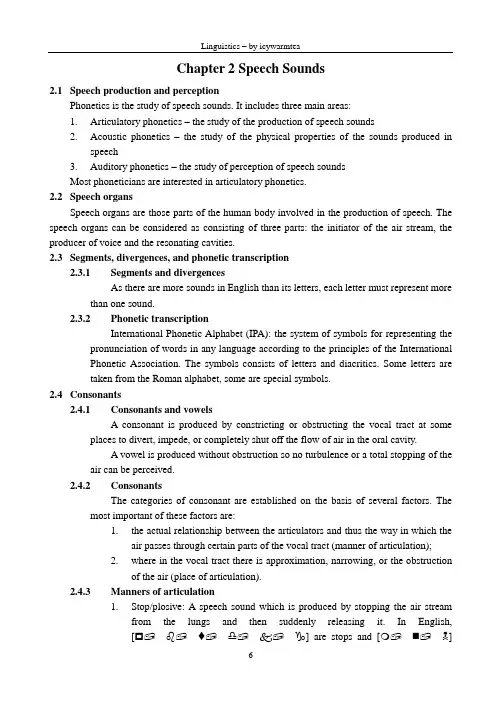
Chapter 2 Speech Sounds2.1 Speech production and perceptionPhonetics is the study of speech sounds. It includes three main areas:1. Articulatory phonetics – the study of the production of speech sounds2. Acoustic phonetics –the study of the physical properties of the sounds produced inspeech3. Auditory phonetics – the study of perception of speech soundsMost phoneticians are interested in articulatory phonetics.2.2 Speech organsSpeech organs are those parts of the human body involved in the production of speech. The speech organs can be considered as consisting of three parts: the initiator of the air stream, the producer of voice and the resonating cavities.2.3 Segments, divergences, and phonetic transcription2.3.1 Segments and divergencesAs there are more sounds in English than its letters, each letter must represent more than one sound.2.3.2 Phonetic transcriptionInternational Phonetic Alphabet (IPA): the system of symbols for representing the pronunciation of words in any language according to the principles of the InternationalPhonetic Association. The symbols consists of letters and diacritics. Some letters aretaken from the Roman alphabet, some are special symbols.2.4 Consonants2.4.1 Consonants and vowelsA consonant is produced by constricting or obstructing the vocal tract at someplaces to divert, impede, or completely shut off the flow of air in the oral cavity.A vowel is produced without obstruction so no turbulence or a total stopping of theair can be perceived.2.4.2 ConsonantsThe categories of consonant are established on the basis of several factors. The most important of these factors are:1. the actual relationship between the articulators and thus the way in which theair passes through certain parts of the vocal tract (manner of articulation);2. where in the vocal tract there is approximation, narrowing, or the obstructionof the air (place of articulation).2.4.3 Manners of articulation1. Stop/plosive: A speech sound which is produced by stopping the air streamfrom the lungs and then suddenly releasing it. In English,[☐ ♌ ♦ ♎ ♑] are stops and [❍ ⏹ ☠]are nasal stops.2. Fricative: A speech sound which is produced by allowing the air stream fromthe lungs to escape with friction. This is caused by bringing the twoarticulators, e.g. the upper teeth and the lower lip, close together but notcloses enough to stop the airstreams completely. In English,[♐ ❆ ♦ ☞ ✞ ♒] are fricatives.3. (Median) approximant: An articulation in which one articulator is close toanother, but without the vocal tract being narrowed to such an extent that aturbulent airstream is produced. In English this class of sounds includes[♦ ❑ ].4. Lateral (approximant): A speech sound which is produced by partiallyblocking the airstream from the lungs, usually by the tongue, but letting itescape at one or both sides of the blockage. [●] is the only lateral in English.Other consonantal articulations include trill, tap or flap, and affricate.2.4.4 Places of articulation1. Bilabial: A speech sound which is made with the two lips.2. Labiodental: A speech sound which is made with the lower lip and the upperfront teeth.3. Dental: A speech sound which is made by the tongue tip or blade and theupper front teeth.4. Alveolar: A speech sound which is made with the tongue tip or blade and thealveolar ridge.5. Postalveolar: A speech sound which is made with the tongue tip and the backof the alveolar ridge.6. Retroflex: A speech sound which is made with the tongue tip or blade curledback so that the underside of the tongue tip or blade forms a stricture with theback of the alveolar ridge or the hard palate.7. Palatal: A speech sound which is made with the front of the tongue and thehard palate.8. Velar: A speech sound which is made with the back of the tongue and the softpalate.9. Uvular: A speech sound which is made with the back of the tongue and theuvula, the short projection of the soft tissue and muscle at the posterior end ofthe velum.10. Pharyngeal: A speech sound which is made with the root of the tongue and thewalls of the pharynx.11. Glottal: A speech sound which is made with the two pieces of vocal foldspushed towards each other.2.4.5 The consonants of EnglishReceived Pronunciation (RP): The type of British Standard English pronunciation which has been regarded as the prestige variety and which shows no regional variation. It has often been popularly referred to as “BBC English” or “Oxford English” because it is widely used in the private sector of the education system and spoken by most newsreaders of the BBC network.articulation. These pairs of consonants are distinguished by voicing, the one appearingon the left is voiceless and the one on the right is voiced.Therefore, the consonants of English can be described in the following way:[p] voiceless bilabial stop[b] voiced bilabial stop[s] voiceless alveolar fricative[z] voiced alveolar fricative[m] bilabial nasal[n] alveolar nasal[l] alveolar lateral[j] palatal approximant[h] glottal fricative[r] alveolar approximant2.5 Vowels2.5.1 The criteria of vowel description1. The part of the tongue that is raised – front, center, or back.2. The extent to which the tongue rises in the direction of the palate. Normally,three or four degrees are recognized: high, mid (often divided into mid-highand mid-low) and low.3. The kind of opening made at the lips –various degrees of lip rounding orspreading.4. The position of the soft palate –raised for oral vowels, and lowered forvowels which have been nasalized.2.5.2 The theory of cardinal vowels[Icywarmtea doesn’t quite understand this theory.]Cardinal vowels are a set of vowel qualities arbitrarily defined, fixed and unchanging, intending to provide a frame of reference for the description of the actualvowels of existing languages.By convention, the eight primary cardinal vowels are numbered from one to eight as follows: CV1[♓], CV2[♏], CV3[☪], CV4[♋], CV5[ ], CV6[ ], CV7[☐],CV8[◆].A set of secondary cardinal vowels is obtained by reversing the lip-rounding for agive position: CV9 – CV16. [I am sorry I cannot type out many of these. If you want toknow, you may consult the textbook p. 47. – icywarmtea]2.5.3 Vowel glidesPure (monophthong) vowels: vowels which are produced without any noticeable change in vowel quality.V owel glides: V owels where there is an audible change of quality.Diphthong: A vowel which is usually considered as one distinctive vowel of a particular language but really involves two vowels, with one vowel gliding to the other.2.5.4 The vowels of RP[♓] high front tense unrounded vowel[◆] high back lax rounded vowel[☜] central lax unrounded vowel[ ] low back lax rounded vowel2.6 Coarticulation and phonetic transcription2.6.1 CoarticulationCoarticulation: The simultaneous or overlapping articulation of two successive phonological units.Anticipatory coarticulation: If the sound becomes more like the following sound, as in the case of lamp, it is known as anticipatory coarticulation.Perseverative coarticulation: If the sound displays the influence of the preceding sound, as in the case of map, it is perseverative coarticulation.Nasalization: Change or process by which vowels or consonants become nasal.Diacritics: Any mark in writing additional to a letter or other basic elements.2.6.2 Broad and narrow transcriptionsThe use of a simple set of symbols in our transcription is called a broad transcription. The use of more specific symbols to show more phonetic detail is referredto as a narrow transcription. The former was meant to indicate only these soundscapable of distinguishing one word from another in a given language while the latterwas meant to symbolize all the possible speech sounds, including even the minutestshades of pronunciation.2.7 Phonological analysisPhonetics is the study of speech sounds. It includes three main areas: articulatory phonetics, acoustic phonetics, and auditory phonetics. On the other hand, phonology studies the rules governing the structure, distribution, and sequencing of speech sounds and the shape of syllables.There is a fair degree of overlap in what concerns the two subjects, so sometimes it is hard to draw the boundary between them. Phonetics is the study of all possible speech sounds while phonology studies the way in which speakers of a language systematically use a selection of these sounds in order to express meaning. That is to say, phonology is concerned with the linguistic patterning of sounds in human languages, with its primary aim being to discover the principles that govern the way sounds are organized in languages, and to explain the variations that occur. 2.8 Phonemes and allophones2.8.1 Minimal pairsMinimal pairs are two words in a language which differ from each other by only one distinctive sound and which also differ in meaning. E.g. the English words tie anddie are minimal pairs as they differ in meaning and in their initial phonemes /t/ and /d/.By identifying the minimal pairs of a language, a phonologist can find out which soundsubstitutions cause differences of meaning.2.8.2 The phoneme theory2.8.3 AllophonesA phoneme is the smallest linguistic unit of sound that can signal a difference inmeaning. Any of the different forms of a phoneme is called its allophones. E.g. inEnglish, when the phoneme /☐/ occurs at the beginning of the word like peak/☐♓/, it is said with a little puff of air, it is aspirated. But when /☐/ occurs in theword like speak /♦☐♓/, it is said without the puff of the air, it is unaspirated. Boththe aspirated [☐♒] in peak and the unaspirated [☐=] in speak have the same phonemicfunction, i.e. they are both heard and identified as /☐/ and not as /♌/; they are bothallophones of the phoneme /☐/.2.9 Phonological processes2.9.1 AssimilationAssimilation: A process by which one sound takes on some or all the characteristics of a neighboring sound.Regressive assimilation: If a following sound is influencing a preceding sound, we call it regressive assimilation.Progressive assimilation: If a preceding sound is influencing a following sound, we call it progressive assimilation.Devoicing: A process by which voiced sounds become voiceless. Devoicing of voiced consonants often occurs in English when they are at the end of a word.2.9.2 Phonological processes and phonological rulesThe changes in assimilation, nasalization, dentalization, and velarization are all phonological processes in which a target or affected segment undergoes a structuralchange in certain environments or contexts. In each process the change is conditioned ortriggered by a following sound or, in the case of progressive assimilation, a precedingsound. Consequently, we can say that any phonological process must have three aspectsto it: a set of sounds to undergo the process; a set of sounds produced by the process; aset of situations in which the process applies.We can represent the process by mans of an arrow: voiced fricative →voiceless / __________ voiceless. This is a phonological rule. The slash (/) specifies theenvironment in which the change takes place. The bar (called the focus bar) indicatesthe position of the target segment. So the rule reads: a voiced fricative is transformedinto the corresponding voiceless sound when it appears before a voiceless sound.2.9.3 Rule ordering[No much to say, so omitted – icywarmtea]2.10 Distinctive featuresDistinctive feature: A particular characteristic which distinguishes one distinctive sound unit of a language from another or one group of sounds from another group.Binary feature: A property of a phoneme or a word which can be used to describe the phoneme or word. A binary feature is either present or absent. Binary features are also used to describe the semantic properties of words.2.11 SyllablesSuprasegmental features: Suprasegmental features are those aspects of speech that involve more than single sound segments. The principal suprasegmental features are syllables, stress, tone, and intonation.Syllable: A unit in speech which is often longer than one sound and smaller than a whole word.Open syllable: A syllable which ends in a vowel.Closed syllable: A syllable which ends in a consonant.Maximal onset principle: The principle which states that when there is a choice as to where to place a consonant, it is put into the onset rather than the coda. E.g. The correct syllabification of the word country should be / ✈⏹♦❑♓/. It shouldn’t be / ✈⏹♦❑♓/ or / ✈⏹♦❑♓/ according to this principle.2.12 StressStress refers to the degree of force used in producing a syllable. In transcription, a raised vertical line [ ] is used just before the syllable it relates to.。
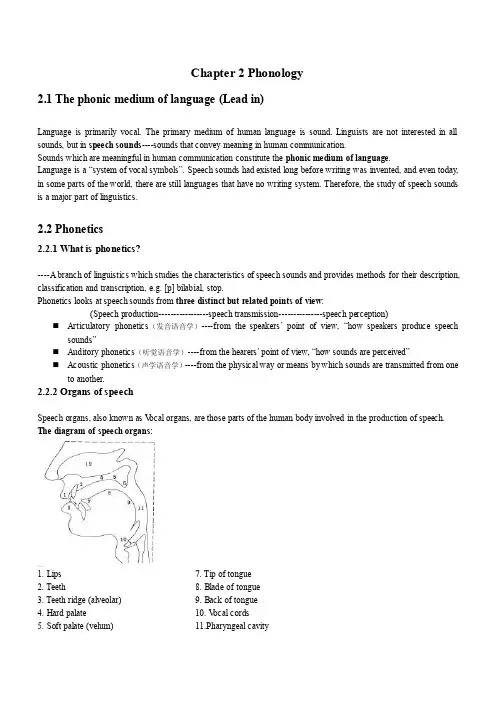
Chapter 2 Phonology2.1 The phonic medium of language (Lead in)Language is primarily vocal. The primary medium of human language is sound. Linguists are not interested in all sounds, but in speech sounds----sounds that convey meaning in human communication.Sounds which are meaningful in human communication constitute the phonic medium of language.Language is a “system of vocal symbols”. Speech sounds had existed long before writing was invented, and even today, in some parts of the world, there are still languages that have no writing system. Therefore, the study of speech sounds is a major part of linguistics.2.2 Phonetics2.2.1 What is phonetics?----A branch of linguistics which studies the characteristics of speech sounds and provides methods for their description, classification and transcription, e.g. [p] bilabial, stop.Phonetics looks at speech sounds from three distinct but related points of view:(Speech production-----------------speech transmission---------------speech perception)⏹Articulatory phonetics(发音语音学)----from the speakers‟point of view, “how speakers produce speechsounds”⏹Auditory phonetics(听觉语音学)----from the hearers‟ point of view, “how sounds are perceived”⏹Acoustic phonetics(声学语音学)----from the physical way or means by which sounds are transmitted from oneto another.2.2.2 Organs of speechSpeech organs, also known as V ocal organs, are those parts of the human body involved in the production of speech. The diagram of speech organs:1. Lips 7. Tip of tongue2. Teeth 8. Blade of tongue3. Teeth ridge (alveolar) 9. Back of tongue4. Hard palate 10. V ocal cords5. Soft palate (velum) 11.Pharyngeal cavity6. Uvula 12. Nasal cavityThe important cavities:☆The pharyngeal cavity 咽腔---- the throatLarynx: at the top of the trachea, the front of which is the Adam‟s apple. This is the first place where sound modification might occur. The larynx contains the Vocal folds, also known as Vocal cords or Vocal bands. The vocal folds are a pair of structure that lies horizontally with their front ends joined together at the back of the Adam‟s apple. Their rear ends, however, remain separated and can move to various positions. The vocal folds are either (a) apart, (b) close together, (c) totally closed.Vibration of the vocal cords results in a quality of speech sounds called voicing, which is a feature of all vowels and some consonants in English.Voiceless: when the vocal cords are spread apart, the air from the lungs passes between them unimpeded.V oiced (V oicing): when the vocal cords are drawn together, the air from the lungs repeated pushes them apart as it passes through, creating a vibration effect.☆The oral cavity 口腔---- the mouthThe oral cavity provides the greatest source of modification of the air stream. ([k]/[g], [t]/[d], [θ]/[δ], [f]/[v], [p]/[b])☆The nasal cavity 鼻腔---- the noseThe nasal cavity is connected with the oral cavity. The soft part of the roof of the mouth, the velum, can be drawn back to close the passage so that all air exiting from the lungs can only go through the mouth. The sounds produced in this condition are not nasalized. If the passage is left open to allow air to exit through the nose, the sounds produced are nasalized sounds.2.2.3 Orthographic representation of speech sounds--- broad and narrow transcriptions(语音的正字法表征:宽式/窄式标音)---- A standardized and internationally accepted system of phonetic transcription is the International Phonetic Alphabet (IPA). The basic principle of the IPA is using one letter to represent one speech sound.Broad transcription: the transcription with letter-symbols only(代表字母的符号)e.g. clear [l]Narrow transcription: the transcription with letter-symbols together with the diacritics. e.g. dark [ l ], aspirated [ p ] (Diacritics are additional symbols or marks used together with the consonant and vowel symbols to indicate nuances of change in their pronunciation.)E.g. : [l]→[li:f]--→ a clear [l] (no diacritic); [l]→[bild]--→a dark [l] (~)[p]→[pit]--→an aspirated [p h](h表示送气)[p]→[spit]--→an unaspirated [p] (no diacritic)2.2.4 Classification of English speech sounds---- English speech sounds are generally classified into two large categories:⏹V owels⏹ConsonantsNote: The essential difference between these two classes is that in the production of the former the air stream meets with no obstruction of any kind in the throat, the nose or the mouth, while in that of the latter it is somehow obstructed.2.2.4.1 Classification of English consonantsEnglish consonants can be classified either in terms of manner of articulation or in terms of place of articulation.In terms of manner of articulation根据发音方法分(the manner in which obstruction is created)① Stops闭塞音: the obstruction is total or complete, and then going abruptly[p]/[b], [t]/[d], [k]/[g]② Fricatives摩擦音: the obstruction is partial, and the air is forced through a narrow passage in the month[f]/[v], [s]/[z], [∫]/[з], [θ]/[δ], [h] (approximant)③ Affricates塞擦音: the obstruction, complete at first, is released slowly as in fricatives [t∫]/[dз]④ Liquids流音: the airflow is obstructed but is allowed to escape through the passage between part or parts of the tongue and the roof of the mouth[l]→a lateral sound; [r]→ retroflex⑤ Glides滑音: [w], [j] (semi-vowels)Liquid + glides + [h]→ approximants⑥ Nasals鼻音: the nasal passage is opened by lowering the soft palate to let air pass through it[m], [n], [η]By place of articulation根据发音部位分(the place where obstruction is created)①bilabial双唇音: upper and lower lips are brought together to create obstructions [p]/[b], [w]→(velar)②labiodentals唇齿音: the lower lip and the upper teeth [f]/[v]③dental齿音:the tip of the tongue and the upper front teeth [θ]/[δ]④alveolar齿龈音: the front part of the tongue on the alveolar ridge [t]/[d], [s]/[z], [n], [l], [r]⑤palatal腭音: tongue in the middle of the p alate [θ]/[δ], [t∫]/[dз], [j]⑥velars软腭音:the back of the tongue against the velum [k], [g], [η]⑦glottal喉音: the glottal is the space between the vocal cords in the larynx [h]Conclusion: Factors to describe a consonant(1) State of vocal cords (VL/VD)(2) Manner of articulation (MA)(3) Place of articulation (PA)2.2.4.2 Classification of English vowelsV owel sounds are classified according to: the position of the tongue in the mouth, the openness of the mouth, the shape of the lips, and the length of the vowels.Highest Part of the tongue (front, central, back)Front vowels are the ones in the production of which the front part of the tongue is raised the highest such as [i:] [i] [e] [æ] [a].When the central part of the tongue maintains its highest position, the vowels thus produced are central vowels such as [3:] [Ə] and [ ] .If the back of the tongue is held the highest, the vowels thus produced are back vowels such as [u:][u] Openness of mouthRounded or unrounded lipsrounded vowels: All the back vowels in English are rounded except [ɑ:].unrounded vowels: All the front vowels and central vowels in English are unrounded.Length of the vowellong vowels: They are usually marked with a colon such as [i:] and [ɑ:]short vowels: other vowels in English are short vowels such as [e], [ə] and [æ].monophthongs: individual vowelsdiphthongs: produced by moving from one vowel position to another through intervening positions. (集中/合口)2.3 Phonology2.3.1 Phonology and phoneticsWhat does English phonetics deal with?English phonetics is concerned with all speech sounds that occur in the English language. It studies how these sounds are produced and how they are described and classified.What does English phonology deal with?English phonology investigates the sound system of English. Different from English phonetics, English phonology is not interested in the actual production of English sounds, but in the abstract aspects:A. the function of sounds--- whether a sound can differentiate the meanings of wordsB. their patterns of combination--- how sounds are combined to form a permissible sound sequence⏹Both are concerned with the same aspect of language----the speech sounds. But they differ in their approachand focus.⏹Phonetics is of general nature; it is interested in all the speech sounds used in all human languages; it aims toanswer questions like: how they are produced, how they differ from each other, what phonetic features they have, how they can be classified, etc.⏹Phonology aims to discover how speech sounds in a language form patterns and how these sounds are used toconvey meaning in linguistic communication.(Speaker‟s mind--- Mouth--- Ear--- Listener‟s mind)2.3.2 Phone, phoneme, and allophonePhoneme: minimal distinctive unit in sound system of a language; a phoneme is a phonological unit; it is a unit of distinctive value, it is an abstract unit; not a particular sound, but it is represented by a certain phone in certain phonetic context, e.g. the phoneme /p/ can be represented differently in [pIt], [tIp] and [spIt].Phone: a phone is a phonetic unit or segment; the realization of phoneme in general. The speech sounds we hear and produce during linguistic communication are all phones. Phones do not necessarily distinguish meaning, some do, some don‟t. For example, in the words feel[fi:ł], leaf[li:f], tar[t h a:], star[sta:],there are altogether 7 phones: [f],[i:],[ł], [l], [t h]. [t], [a:], but [ł] and[l] do not distinguish meaning, [t h] and [t] do not distinguish meaning as well.Allomophone: the different phones which can represent a phoneme in different phonetic environments are called the allophones of that phoneme; realizations of a particular phoneme.2.3.3 Phonemic contrast, complementary distribution, and minimal pairPhonemic contrast: when two phonemes can occur in the same environments in two words and they distinguish meaning, they‟re in phonemic contrast.E.g. pin & bin → /p/ vs. /b/ rope & robe → /p/ vs. /b/Complementary distribution:two or more than two allophones of the same phonemes are said to be in complementary distribution because they can not appear at the same time, or occur in different environment, besides they do not distinguish meaning.E.g. dark [l] & clear [l], aspirated [p] & unaspirated [p]Minimal pair: when two different forms are identical in every way except for one sound segment which occurs in the same place in the strings, the two sounds are said to form a minimal pair.E. g. mail vs. nail beat, bit, bet, bat, boot, but, bait, bite, boat2.3.4 Some rules in phonology2.3.4.1 Sequential rulesSequential rules ---- the rules that govern the combination of sounds in a particular language, e.g. in English, “k b i I” might possibly form blik, klib, bilk, kilb.⏹If a word begins with a [l] or a [r], then the next sound must be a vowel.⏹If three consonants should cluster together at the beginning of a word, the combination should obey thefollowing three rules, e.g. spring, strict, square, splendid, screama) the first phoneme must be /s/,b) the second phoneme must be /p/ or /t/ or /k/,c) the third phoneme must be /l/ or /r/ or /w/.⏹The affricates [t∫],[dз] and the sibilants [s],[z],[θ],[δ]are not to be followed by anothersibilants.2.3.4.2 Assimilation ruleAssimilation: articulatory adaptation of one sound to a nearby sound with regard to one or more features.Nasalization: /m/, /n/, /ŋ/[-nasal]→ [+nasal]/_______ [+nasal]Dentalization: /ð/, /θ/[-dental]→[+dental]/______[+dental]V elarizatio n: /k/, /g/, / ŋ/: Word-final /n/ becomes velar before velar plosives/k, g/: ten cups; ten girls[-velar]→ [+ velar]/______[+velar]2.3.4.3 Deletion ruleDeletion rule---- it tells us when a sound is to be deleted although it is orthographically represented, e.g. design, paradigm, there is no [g] sound; but the [g] sound is pronounced in their corresponding forms signature, designation, paradigmatic.E.g. delete a [g] when it occurs before a final nasal consonant 省略词末鼻辅音前的[g]音2.3.5 Suprasegmental features--- stress, tone, intonationsegmental features(切分特征)--- the distinctive features which can only have an effect on one sound segment are called segmental features.Suprasegmental features----the phonemic features that involve more than single sound segments (larger than phoneme)2.3.5.1 StressWord stress⏹The location of stress in English distinguishes meaning, e.g. a shift in stress in English may change the part ofspeech of a word:verb: im‟port; in‟crease; re‟bel; re‟cord …noun: …import; …increase; …rebel; …record …⏹Similar alteration of stress also occurs between a compound noun and a phrase consisting of the sameelements:compound: …blackbird; …greenhouse; …hotdog…noun phrase: black …bird; green …house; hot …dog…⏹The meaning-distinctive role played by word stress is also manifested in the combinations of -ing forms andnouns:modifier: …dining-room; …reading room; …sleeping bag…doer: sleeping …baby; swimming …fish; flying …plane…Sentence stressSentence stress----the relative force given to the components of a sentence. Generally, nouns, main verbs, adjectives, adverbs, numerals and demonstrative pronouns are stressed. Other categories like articles, person pronouns, auxiliary verbs prepositions and conjunctions are usually not stressed.Note: for pragmatic reason, this rule is not always right, e.g. we may stress any part in the following sentences.He is driving my car.My mother bought me a new skirt yesterday.2.3.5.2 T oneTones are pitch variations, which are caused by the differing rates of vibration of the vocal cords.⏹English is not a tone language, but Chinese is.ma 妈(level)ma 麻(the second rise)ma 马(the third rise)ma 骂(the fourth fall)2.3.5.3 IntonationWhen pitch, stress and length variations are tied to the sentence rather than to the word, they are collectively known as intonation.English has three types of intonation that are most frequently used (first three types):falling tone (matter of fact statement)rising tone (doubts or question)the fall-rise tone (implied message)the rise-fall toneHe is not ↘ there. What did you put in my ↗ drink, ↘ Jane?He is not ↗ there? What did you put in my ↘ drink, ↗ Jane?For instance,“That’s not the book he wants.”Ss exercise: Explain the meaning of the following words or phrases or sentences when marked with different stress or with different intonation.Assignments1. Ss complete the review questions during the classes.2. Ask students to do the exercises 1-10 on Page 30.。
英语语⾔学Chapter2Chapter T woⅡ. Fill in each of the following blanks with one word which begins with the letter given:1. A refers to a strong puff of airstream in the production of speech sounds.2. A phonetics describes the way our speech organs work to produce the speech sounds and how they differ.3. The four sounds /p/, /b/, /m/ and /w/ have one feature in common, i.e., they are all bsounds.4. Of all the speech organs, the t is the most flexible, and is responsible for varieties of articulation than any other.5. English consonants can be classified in terms of manner of articulation or in terms of pof articulation.6. When the obstruction created by the speech organs is total or complete, the speech sound produced with the obstruction audibly released and the air passing out again is called ass.7. S features are the phonemic features that occur above the level of the segments. They include stress, tone, intonation, etc.8. The rules that govern the combination of sounds in a particular language are called srules.9. The transcription of speech sounds with letter-symbols only is called broad transcription while the transcription with letter-symbols together with the diacritics is called ntranscription.10. When pitch, stress and sound length are tied to the sentence rather than the word in isolation, they are collectively known as i.11. P is a discipline which studies the system of sounds of a particular language and how sounds are combined into meaningful units to effect linguistic communication.12. The articulatory apparatus of a human being are contained in three important cavities: the pharyngeal cavity, the o cavity and the nasal cavity.13. T one are pitch variations, which are caused by the differing rates of vibration of the vocal cords and which can distinguish meaning just like phonemes.14. Depending on the context in which stress is considered, there are two kinds of stress: word stress and s stress.perception.16. The articulatory apparatus of a human being are embedded in three important cavities. These three cavities are p o and n cavitythe production of them.18. Vis a feature of all vowels and some consonants. When the vocal cords do cause vibration, the sounds produced are ; otherwise they are named sounds19. Two ways to transcribe speech sounds are available, broad transcription and narrow transcription. The major difference between them is with or without .20. When the obstruction is partial and the air is forced through an arrow passage in the mouth soas to cause definite local friction at the point, the speech sound thus produced is a .21. The basic unit of phonology is a phoneme. It is an abstract collection of .22. When phonemic contrast is mentioned we realize that the two sounds belong tophoneme(s), when complementary distribution is discussed, the allophones come from phoneme(s); and finally when free variation is talked about, we understand that the sounds are derived from phoneme(s).23. In English, complementary distribution of allophones is required to meet two conditions, one condition is that they never occur in the ; the other is that they shouldshare .24. In English, the study of phonology hasso far mainly found three phonological rules. They areand rule.III. There are four choices following each statement. Mark the choice that can best complete the statement:1. Of all the speech organs, the _______is/are the most flexible.A. mouthB. lipsC. tongueD. vocal cords2. The sounds produced without the vocal cords vibrating are ____ sounds.A. voicelessB. voicedC. vowelD. consonantal3. __________ is a voiced alveolar stop.A. /z/B. /d/C. /k/D. /b/4. The assimilation rule assimilates one sound to another by “copying” a feature of a sequential phoneme, thus making the two phones ____________.A. identicalB. sameC. exactly alikeD. similar5. Since /p/ and /b/ are phonetically similar, occur in the same environments and they can distinguish meaning, they are said to be ___________.A. in phonemic contrastB. in complementary distributionC. the allophonesD. minimal pair6. The sound /f/ is _________________.A. voiced palatal affricateB. voiced alveolar stopC. voiceless velar fricativeD. voiceless labiodental fricative7. A ____ vowel is one that is produced with the front part of the tongue maintaining the highest position.A. backB. centralC. frontD. middle8. Distinctive features can be found running over a sequence of two or more phonemic segments. The phonemic features that occur above the level of the segments are called _______.A. phonetic componentsB. immediate constituentsC. suprasegmental featuresD. semantic features9. A(n) ___________ is a unit that is of distinctive value. It is an abstract unit, a collection of distinctive phonetic features.A. phoneB. soundC. allophoneD. phoneme10. The different phones which can represent a phoneme in different phonetic environments are called the ____ of that phoneme.A. phonesB. soundsC. phonemesD. allophones11. Phonetics is the study of _______.A. all the sounds that occur in the world’s languagesB. speech sounds used by human languages to representC. the differences between sounds used inhuman languages and sounds in natureD. how phonological differences can lead to misunderstanding12. /m, n/ are _______.A. fricativesB. dentalsC. glidesD. nasals13. /w, j/ belong to _______.A. fricativesB. dentalsC. glidesD. nasals14. Which of the following vowel is the rounded vowel?A. [i:]B. [u:]C. [i]D. [a:]15. In the field of phonology, which of the following does NOT belong to the suprasegmental features?A. stressB. toneC. intonationD. syllable16. Classification of vowels is made up of the following EXCEPT _______.A. the position of the tongueB. the openness of the mouthC. the shape of the lipD. the width of the vowels17. A sound which is capable of distinguishing one word or one shape of a word from another in a given language is a ______.A. phonemeB. allophoneC. phoneD. allomorph18. /p, t, k/ are _______.A. fricativesB. affricatesC. glides19. /kuku:/ is a bird’s call. The name of such a bird is CUCKOO which is an example of ______.A. language universalsB. onomatopoeiaC. teaching grammarsD. morphs20. The vowel [u:] in [fu:d] (food) is a______ vowel.A. backB. frontC. unroundedD. central21. In English, there is only one glottal. It is ______.A. [f]B. [r]C. [h]D. [v]22. Which of the following sounds is a voiced bilabial stop?A. [m]B. [v]C. [p]D. [b]23. The different phones which can represent a phoneme in different phonetic environments are called the _______ of that phoneme.A. minimalB. allomorphC. phonesD. allophones24. [i:], [i], [e] are all ______ vowels.A. frontB. centralC. backD. back25. Which of the following is a fricative sound?A. [m]B.[p]C.[w]26. There are _______ nasals in English.A. oneB. twoC. threeD. four27. _______ are not a minimal pair in English.A. “sink” and “zinc”B. “fine” and “vine”C. “bat” and “pat”D. “teach” and “cheat”。
Chapter 2Revision exercises reference1.What are the two major media of communication? Of the two, which one isprimary and why?Refer to section 2.1The two major media of communication are speech and writing. Of the two, speech is considered primary for the following reasons: 1) from the point of view of linguistic evolution, speech is prior to writing. The writing system of any language is always a later invention. 2) In everyday communication, speech conveys a greater amount of information than writing. 3) Speech is always the way in which every native speaker acquires his mother tongue, and writing is learned and taught later as part of formal education.2.What is voicing and how is it caused?Refer to section 2.2.2 (1)V oicing is a phonetic feature of some speech sounds. It is caused by the vibration of the speaker's vocal cords when he produces a certain sound. If a sound bears this feature, it is voiced. If such a feature is absent in the pronunciation of a sound, it is voiceless. All vowels in English are voiced; and some consonants in English are voiced such as [d] and [v] while others are voiceless such as [p] and [s].3.Explain with examples how broad transcription and narrow transcriptiondiffer.Both broad and narrow transcriptions are ways to transcribe speech sounds, i.e.ways of using written symbols to represent speech sounds. In broad transcription, only the letter symbols are used, and the principle is to use one letter for onesound, such as [P] and [I]. In narrow transcription, a set of symbols calleddiacritics are added to the letter symbols to show the finer differences between similar sounds, such as[P h] and [ɫ].4.How are the English consonants classified?As in the pronunciation of consonants the air stream coming from the lungs is somehow obstructed, it is possible and also necessary to classify them in terms of manner of articulation and place of articulation. In terms of manner of obstruction, the consonants are classified into the following groups: stops, fricatives, affricates, liquids, nasals and glides. In terms of place of obstruction, the consonants are classified into the following groups: bilabial, labiodental, dental, alveolar, palatal, velar, and glottal.5.What criteria are used to classify the English vowels?To classify the English vowels, the following criteria can be applied: position of the tongue, openness of the mouth, length of the vowels, and the shape of the lips.According to the position of the tongue, the vowels are classified into front, central and back vowels; according to the openness of the mouth, the vowels are classified into close, semi-close, semi-open, and open vowels; and according to the length of the vowels, they are classified into long vowels and short vowels;and according to the shape of the lips, and the vowels are classified into rounded and unrounded vowels.6.Give the phonetic symbol for each of the following sound descriptions:1)voiced palatal affricate--- [dʒ]2)voiceless labiodental fricative---[f]3)voiced alveolar stop---[d]4)front, close, short---[i]5)back ,semi-open, long ---[ɔ:]6)voiceless bilabial stop---[p]Given the phonetic features of each of the following sounds:1)[d]---voiced alveolar stop2)[l]---voiced alveolar liquid3)[tʃ]---voiceless palatal/alveolar affricate4)[w]---voiced bilabial glide5)[u]---back,close,short(rounded)6)[æ]---front,short,open(unrounded)7.How do phonetics and phonology differ in their focus of study? Who do youthink will be more interested in the difference between, say, [l]and[ɫ], [pʰ]and[P],a phonetician or a phonologist? Why?Refer to section 2.3.1Though both dealing with speech sounds, phonetics and phonology differ in their focus of study in that the former focuses on the speech sounds themselves, their ways of pronunciation, their differences, their classifications, etc., while the latter focuses on the sound system of particular languages and the role sounds play in conveying meaning. Therefore, a phonetician will be more interested in the difference between two sounds.8.What is a phone? How is it different from a phoneme? How are allophonesrelated to a phoneme?Refer to section 2.3.2A phone is simply a speech sound, every actual sound we use or hear inmeaningful linguistic communication. For example, in pronouncing the two words “feel” and “leaf”, we actually use or hear four phones:[f][i:][l]and[~l].A phone differs from a phoneme in that the former is an actual sound we hear andit is the unit of study in phonetics, and the latter is not an audible sound, but an abstract entity, a collection of phonetic features, used as a unit of study in phonology. Take the “feel” and “leaf” example again. While four phones are used or heard in the pronunciation of these two words, only three phonemes are involved, i.e. /f/ /i: / and /l/.A phoneme, though as an abstract entity, is realized as different phones indifferent phonetic contexts. All these different phones are called the allophones of the same one phoneme. For example, the aspirated [pʰ] and the unaspirated [p] are allophones of the same phoneme/p/.9.Explain with examples the sequential rules, the assimilation rule, and thedeletion rule.Sequential rules are rules that govern the combination of sounds in a particular language. For exam ple, why “klib” is a permissible combination of the four sounds in English and why “kbli” is not can only be accounted for by a sequential rule.The assimilation rule assimilates one sound to another by “copying” a feature of a sequential phoneme, thus making the two phones similar. For example, the actual pronunciation of the letter “n” in the word “ incorrect” is not the alveolar [n] but the velar nasal [ŋ] is a manifestation of the assimilation rule at work.The deletion tells us when a sound is deleted although it is orthographically represented. For example, in the pronunciation of such words as sign, design, and paradigm, there is no [g] sound although it is represented in spelling by the letterg. But in their corresponding noun forms signature, designation and paradigmatic,the [g] represented by the letter g is pronounced.10.What are Suprasegmental features? How do the major Suprasegmentalfeatures of English function in conveying meaning?Suprasegmental features refer to those phonological features occurring above the sound segment level. The major Suprasegmental features in English are stress and intonation. The shift of word stress may change the part of speech of words of the same spelling, such as “'progress n.” and “pro'gress v.” , and different stress may cause difference in the meaning of some compound nouns and noun phrases with the same components, such as “'hotdog” and “hot 'dog”. Stressing words that are normally unstressed in a sentence may convey some extra meaning by the speaker.For exam ple, by stressing the pronoun “my” in the sentence “He is driving 'my car” the speaker is emphasizing the fact that the car he is driving is no one else`s but the speaker`s.The three often-used intonations in English are the falling tone, the rising tone, and the fall-rise tone. The basic role they each play is that the falling tone states a fact, the rising tone raises a question, and the fall-raise tone implies some meaning not literally expressed. For example, the same sentence “That`s not the book he w ants” said in the three different intonations convey three different meanings.Supplementary ExercisesI. Decide whether each of the following statements is True or False:1.If two phonetically similar sounds occur in the same environments and they distinguishmeaning, they are said to be in complementary distribution.2. A phone is a phonetic unit that distinguishes meaning.3.English is a tone language while Chinese is not.4.In linguistic evolution, speech is prior to writing.5.In everyday communication, speech plays a greater role than writing in terms of the amountof information conveyed.6.Articulatory phonetics tries to describe the physical properties of the stream of sounds whicha speaker issues with the help of a machine called spectrograph.7.The articulatory apparatus of a human being are contained in three important areas: the throat,the mouth and the chest.8.Vibration of the vocal cords results in a quality of speech sounds called voicing.9.English consonants can be classified in terms of place of articulation and the part of thetongue that is raised the highest.10.According to the manner of articulation, some of the types into which the consonants can beclassified are stops, fricatives, bilabial and alveolar.11.Any sound produced by a human being is a phoneme.12.Distinctive features of sound segments can be found running over a sequence of two or morephonemic segments.II. Fill in each of the following blanks with one word which begins with the letter given:13. A ____ refers to a strong puff of air stream in the production of speech sounds.14.The four sounds /p/,/b/,/m/ and /w/ have one feature in common, i.e., they are all b_______sounds.15.S_________ features are the phonemic features that occur above the level of the segments.They include stress, tone, intonation, etc.16.The rules that govern the combination of sounds in a particular language are called s ____rules.17.P___________ is a discipline which studies the system of sounds of a particular language andhow sounds are combined into meaningful units to effect linguistic communication.18.Depending on the context in which stress is considered, there are two kinds of stress: wordstress and s_________ stress.III. There are four choices following each of the statements below. Mark the choice that can best complete the statement:19.Of all the speech organs, the _______ is/ are the most flexible.A. mouthB. lipsC. tongueD. vocal cords20.__________ is a voiced alveolar stop.A. /z/B. /d/C. /k/D. /b/21.Since /p/ and /b/ are phonetically similar, occur in the same environments and they candistinguish meaning, they are said to be ___________.A. in phonemic contrastB. in complementary distributionC. the allophonesD. minimal pair22. A ____ vowel is one that is produced with the front part of the tongue maintaining the highestposition.A. backB. centralC. frontD. middle23.Distinctive features can be found running over a sequence of two or more phonemicsegments. The phonemic features that occur above the level of the segments are called ____________.A. phonetic componentsB. immediate constituentsC. Suprasegmental featuresD. semantic features24.A(n) ___________ is a unit that is of distinctive value. It is an abstract unit, a collection ofdistinctive phonetic features.A. phoneB. soundC. allophoneD. phoneme。
英语语言学第二章讲课课件一、教学内容本节课我们将学习英语语言学第二章,主要内容包括:语系与语言分类、语音学与音系学基础、以及词汇学初步。
具体涉及教材第二章的13节,重点探讨语言的起源、语言如何通过语音和词汇表达意义,以及不同语言之间的相似与差异。
二、教学目标1. 理解世界主要语系的特点及其分类依据,能列举至少三种语系并说明其代表性语言。
2. 掌握语音学基本概念,识别不同语音特征,并能在实际语境中进行应用。
3. 运用词汇学知识分析词语构成,提高词汇理解和运用能力。
三、教学难点与重点重点:语音学基本概念、词汇学的主要理论。
难点:语音的发音规则、词汇在不同语境中的应用。
四、教具与学具准备教具:PPT展示、录音机、语音示例CD。
学具:笔记本、词典、语音学基础教材。
五、教学过程1. 导入(5分钟):通过展示世界地图,引入不同地区语言的多样性,激发学生对语言起源和分类的兴趣。
2. 理论讲解(20分钟):介绍语系分类、语音学基础和词汇学构成,结合教材第二章13节内容。
3. 实践情景引入(10分钟):播放不同语言的问候语录音,让学生体验语言差异。
4. 例题讲解(15分钟):讲解语音学中元音、辅音的分类及发音规则,通过例词进行示范。
5. 随堂练习(10分钟):分组进行语音模仿和词汇构造练习。
六、板书设计1. 语系与语言分类印欧语系汉藏语系阿尔泰语系2. 语音学基础元音与辅音发音规则3. 词汇学初步词根、词缀词语构成七、作业设计beautifulunderstand2. 答案:beautiful: beauty, beautifully, beastunderstand: understanding, understandable, misunderstand八、课后反思及拓展延伸1. 反思:关注学生在课堂上的参与度,针对语音模仿环节进行教学调整,提高学生的发音准确性。
2. 拓展延伸:鼓励学生课下阅读更多关于语音学和词汇学的资料,了解语言的发展趋势及其背后的文化因素。